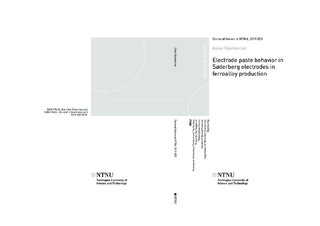| dc.description.abstract | The main goal of this work has been to study the melting behavior of electrode paste used in Søderberg electrodes in ferroalloy production. It has been done by first measuring temperatures in an industrial electrode and identifying the temperature profiles the electrode paste goes through before baking. In the second part flow of electrode paste has been studied in a parallel plate viscometer.
Long thermocouples were used to measure the temperature in steel cylinders following the electrode casing, from a couple of meters above the molten paste level down to below the contact clamp tip. The temperature measurements show that the molten paste has a temperature of 80° C, and that temperatures of up to 280° C are reached above the contact clamp. The high temperatures above the contact clamp are caused by induced currents from the current tubes coming close to the electrode casing before entering the contact clamps.
A COMSOL model was used to model the effect of increased heating above the contact clamps, where after the model was compared to the experimental temperature measurements done. The model shows that by reducing the induced heating from the current tubes, the temperatures can be significantly lowered in the area above the contact clamps. Installing copper shields or increased flow of electrode air can be used to reduce the heating from induced currents in casing.
The flow measurements in the parallel plate viscometer showed that electrode paste is a non- Newtonian liquid with shear thinning characteristics in the temperature range 20-80° C. The electrode paste starts to flow at temperatures 25° C below the softening point of the binder. The electrode pastes tested in this work reach half the original height at around 75° C.
The viscosities measured in the parallel plate viscometer are apparent viscosities as many of the assumption in the underlaying equations are not followed in the measurement set-up used. Among other things the shear rate varies during measurements and is not even throughout the sample. Thus, apparent viscosity found in this work is only applicable under the same conditions as the experiments done, but can be used, with awareness of the measurement limitations, in industrial electrodes as measurement conditions are close to what is observed in industrial electrodes.
A mix of coal-tar pitch and fines were found to behave non-Newtonian liquid behavior above 30 % addition of anthracite fines. Increased fines content increases the viscosity of the mix and at 73% fines content the system is “locked” and does not flow.
The influence of coarse particles on electrode paste flow has also been studied in the parallel plate viscometer, where increased coarse content was found to increases apparent viscosity. Apparent viscosity of electrode pastes with more than 60 % coarse particles are heavily influenced by particle-particle interactions, as apparent viscosity does not increase much with more addition of coarse material. Paste with 70 % coarse particles have very little flow up to temperatures of 120 °C. | nb_NO |
